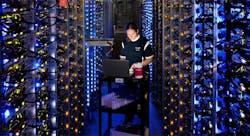Data Center Frontier turned two years old this week. It’s a good time to reflect on our journey this far, contemplate the road ahead, and check in on some of our predictions.
We continue to be guided by our mission statement: “Data Center Frontier charts the future of data centers and cloud computing. We write about what’s next for the Internet, and the innovations that will take us there.”
The data center industry is building the future of our digital economy. I can’t imagine a more interesting beat, and I’m grateful to our readers and sponsors for supporting this mission, as well as the many executives and thought leaders that have shared their time and insights to help us tell this important story.
Our first article on June 23, 2015 was titled “The Future of the Cloud Data Center” and laid out our core thesis on how the rise of cloud computing would reshape the data center industry.
How did we do on those launch predictions? Let’s take a look:
Scale, More Hyper Than Ever
Our prediction: “The largest cloud facilities are getting larger, concentrating enormous amounts of cloud capacity on multi-facility campuses … As giant cloud players compete on price, these rural cloud hubs will become even more important, offering economies of scale in the form of abundant land, cheap power and cool climate.”
What Actually Happened: This trend has been realized on all fronts. Switch, Facebook and CyrusOne are all building single data center structures of 1 million square feet or more. Mega-campuses of 1 million to 6 million square feet are becoming standard for the largest cloud builders, while data center REITs are signing “super wholesale” leases with hyperscale tenants ranging from 15 to 30 megawatts. This prediction is confirmed.
The Cloud Extends Toward the Edge
Our prediction: “The convergence of cloud computing, Big Data and the Internet of Things will require the data center industry to expand well beyond the traditional “Big Six” markets – Northern Virginia, New York/New Jersey, Chicago, Dallas, Silicon Valley and Los Angeles – that have traditionally been magnets for third-party service providers.”
What Actually Happened: Over the past 18 months we’ve seen a flurry of M&A activity and new investments targeting regional “second tier” data center markets, including the acquisition of ViaWest, Cologix, 365 Data Centers, and C7 Data Centers and new lead investors for Compass. EdgeConneX and TierPoint have continued to build out their networks of data centers in second-tier cities, while new initiatives like Vapor IO’s Project Volutus are planning edge networks at telecom towers. This prediction is confirmed.
Design Drives New Opportunities.
Our prediction: “Design will continue to serve as a differentiator as new capacity is deployed at all points of the network. … Designs employing pre-fabrication and lean construction techniques will become especially important.”
What Actually Happened: Lean construction has indeed played a starring role in one of the most important industry trends: accelerating the construction cycle to deliver data center capacity to meet the growth timelines for cloud computing providers. This is driving innovation in the supply chain as developers seek to go from dirt to a completed facility in as little as six months. One miss: Our prediction envisioned a larger role for modular data centers than we have seen to date. This prediction is partially confirmed.
A Growing Role for Renewable Energy
Our prediction: “Some of these new facilities will seek new sources of energy, especially renewable technologies such as wind and solar, as well as landfills and other sources of biogas.”
What Actually Happened: The data center industry has emerged as a leading player in the market for renewable energy, as cloud computing platforms shift to solar and wind to power their servers. In 2016, data center providers signed contracts for more than 1.2 gigawatts of renewable power, with Google and Amazon Web Services exceeding 400 megawatts in power purchase agreements. Adoption is now extending to multi-tenant service providers, as colo customers advocate for green power. Even Greenpeace, one of the industry’s harshest critics, has acknowledged the significant progress. This prediction is confirmed.
Energy Efficiency Still Matters
Our prediction: “Cost will continue to be the primary “green” motivation. Industry innovators will continue to lead with efficiency, targeting opportunities from the chip to the grid.”
What Actually Happened: OK, this one was a layup. Designing for energy efficiency has become a core practice of the data center industry, with years of focus on best practices continue to ripple beyond the cloud builders to improve the efficiency of multi-tenant service providers. Equinix, RagingWire and Compass have all introduced new designs adopting Kyoto Cooling to boost efficiency and reduce their use of water. Aligned Energy entered the market with a cooling system designed to support efficient operations even in warm weather markets. This prediction is confirmed.
The Road Ahead
Two years on, the data center industry faces a new set of emerging technologies that will continue to mold the industry. At Data Center Frontier we are keenly focused on these new technologies – including artificial intelligence (AI), 5G connectivity, the Internet of Things, augmented reality and autonomous vehicles.
What will the next two years look like? In coming months, we will continue to explore the forces shaping our rapidly-evolving technology landscape, and what it means for the data center and cloud computing sector.
Join us on this journey, and invite your friends and colleagues to come along. You can follow us on Twitter and Facebook, connect with me on LinkedIn, and signing up for our weekly newsletter using the form below:
About the Author



